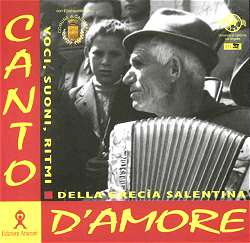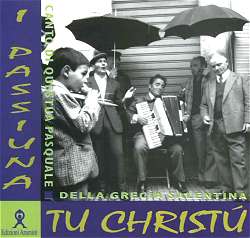 The slim CD case now has an inlay card and tray-paper - although all three (booklet, CD and slip-case) have exactly the same graphics and text front and back ... something of a waste of space, not to mention redundancy of information.
The slim CD case now has an inlay card and tray-paper - although all three (booklet, CD and slip-case) have exactly the same graphics and text front and back ... something of a waste of space, not to mention redundancy of information.
Voci, suoni, ritmi della Grecìa Salentina
(voices, music, rhythms of Grecìa Salentina)
Edizioni Aramirè EA02
This is the second of Roberto Raheli's CD releases of Luigi Chiriatti's collection of Salentine traditional music. Readers may wish to refer to my review of Volume 1 for an introductory piece about the series.
In it, I commented that these CDs are accompanied by very substantial booklets - the one with this present volume has 180 pages and is fully 12mm thick! Half of it is in English. Many of my reservations regarding Vol 1 are no longer valid for the Vol 2 booklet. It is no longer attached to the CD, but comes, with the separate record, in a large slip-case.  The slim CD case now has an inlay card and tray-paper - although all three (booklet, CD and slip-case) have exactly the same graphics and text front and back ... something of a waste of space, not to mention redundancy of information.
The slim CD case now has an inlay card and tray-paper - although all three (booklet, CD and slip-case) have exactly the same graphics and text front and back ... something of a waste of space, not to mention redundancy of information.
The booklet contents mirror the layout design of Vol 1, but rather better printed and organised. The English version is now always on the right-hand page, opposite the Italian one - so it's easy to check on any oddly translated words or phrases. The final 37 pages are taken up with the transcriptions of the song tunes - this time, without the incongruity of Luigi Lezzi's superb piece on 'The Transcription of Ethnic Music' preceding them. A number of Chiriatti's atmospheric photos are shown full-page (see below), and there are now some fairly substantial notes on the songs themselves - although they are placed in a section by themselves, rather than being with the song text and performance details ... very odd, because all the songs do have a short note included in this position as well!
Almost half of the booklet is taken up with a Preface (by Chiriatti), Editor's Note (by Raheli) and Introduction (by Luisa Del Giudice of the Italian Oral History Institute and the University of California). The reason that so much explanation is necessary is that this CD (and Vol 3) is concerned with the songs of the Griko-speaking areas of Salento ... and it would appear that few Italians know any more than you or I do about this unusual cultural phenomenon.
For a full and often fascinating account I can only suggest that you buy the CD (info at the foot of this page) and read the whole of the 58 introductory pages - or the 29 English ones - yourself. In brief, any atlas will show you that Salento (the 'heel' of Italy's 'boot') is only about 50 miles across the Straight of Otranto from northern Greece, and the area was quite extensively settled by Greek emigration from the earliest times. Subsequent waves of Hellenistic emigration served to maintain the Greek elements of the dialect and culture, even into quite recent times ... A 1964 census found that, in the Grecìa Salentina area, slightly more than half of the population of 38,160 still spoke Griko. It also revealed, sadly, that 80% of these Griko speakers were over 55 years of age - the results of which are fairly obvious ...
Membership of the EC, coupled with the current interest in tarrantismo and the pizzica music which accompanies it, have engendered both a renewed sense of cultural pride, and opportunities to promote it in the wider world. This CD is just one of the many examples of this energy being manifested. It is hoped that it may contribute in the drive to save the Griko language - now on the brink of extinction.
So much for what the booklet does offer. What it does not offer is anything more than the names of the singers and musicians, and where they were recorded. My feelings of outrage at this omission probably do not need reiterating yet again here ... but no excuse or reason is good enough - ever! Nonetheless, other people see things differently and have other priorities (as we have found with some of the Alan Lomax Collection releases on Rounder) and we must respect their choices, even when we strongly disagree with them. Certainly there is a great deal which is very good about this booklet.
Volume 2's CD offers a wide range of song types and performance styles, but is maybe a little less accessible to the first-time listener than was Vol 1. It is also, at 42 minutes, rather short - but this may well be due to the fact that Vol 3 also covers the music of Grecìa Salentina and that there is too much of it to fit on a single CD. As someone previously unacquainted with any of this music, I would say that - superficially at least - the melodic and stylist elements of the Griko speaking area are not greatly at odds with those of the surrounding Salentine region, and that it is the use of the Griko language which is the principal difference.
I use the word 'language' in relation to Griko because it's clearly very much more than a dialect. The editor explains the problems of producing transcriptions of these song texts: Griko is only an oral language - it has not, generally, been written down at all, and is not very amenable to being written in either the Greek or Italian alphabets; each of the nine towns where Griko survives has its own 'dialect' of the language; transcribers tend, naturally, to hear their 'own' version of a particular word rather than what has actually been said. Since the 1950s the language has tended to be used mainly in family and local community situations, whilst other business was carried on in the Salentine Romance dialect of the nearest provincial centre or, at a higher level, in the local approximation of the official Italian language. One can imagine that these problems are common to all such attempts to resurrect a dying language - remember Flan O'Brien's The Poor Mouth?
It has been said, apparently, that most Apulian songs (Apulia is the Italian province in which Salento lies) are concerned with religion or sexuality. It would appear to be as true of Grecìa Salentina, since all but two of the songs on Vols 2 and 3 deal with these themes. All of Vol 3 and two tracks here are religious in nature, eight are love songs of some sort - and the odd two are a lullaby and a song listing the peculiarities of the inhabitants of a number of local towns. I have mentioned before that Italian lullabies (almost universally called ninna-nanna) ![]() are seldom of the soft, gentle, soothing variety we are familiar with in these islands - rather relying on rhythm and rocking to induce sleep. Here's a sound clip from one from Martano, sung by Assunta Lucia de Pascalis and I Rizzo. The notes tell us that these niní niní rarely have a set text or narrative line; rather that the women use them to express their inner thoughts and feelings, both towards their children and to society itself. This one deals with: fish; priests; good-looking men; pretty clothes; and cuckoldry! The 'insults' song, Ce tomba tombi, sung, again in Martano, by Pantaleo Stromeo and Salvatore Russo with Raffaele de Santis on accordion,
are seldom of the soft, gentle, soothing variety we are familiar with in these islands - rather relying on rhythm and rocking to induce sleep. Here's a sound clip from one from Martano, sung by Assunta Lucia de Pascalis and I Rizzo. The notes tell us that these niní niní rarely have a set text or narrative line; rather that the women use them to express their inner thoughts and feelings, both towards their children and to society itself. This one deals with: fish; priests; good-looking men; pretty clothes; and cuckoldry! The 'insults' song, Ce tomba tombi, sung, again in Martano, by Pantaleo Stromeo and Salvatore Russo with Raffaele de Santis on accordion, 
![]() lists several local towns and suggests that their inhabitants are stereotypically fat, poor, crazy or gluttonous, and likens them to dogs, asses and lambs ... one must assume that these animals have a local scatological significance of which we are unaware. The song, and their singing, is startlingly blues-like; I've never heard anything quite like this before anywhere in Italy. (sound clip)
lists several local towns and suggests that their inhabitants are stereotypically fat, poor, crazy or gluttonous, and likens them to dogs, asses and lambs ... one must assume that these animals have a local scatological significance of which we are unaware. The song, and their singing, is startlingly blues-like; I've never heard anything quite like this before anywhere in Italy. (sound clip)
The two religious songs included here are, at over 4 and over 6 minutes duration, the longest pieces on the CD. The first is a solo Passiuna tu Christú which was heard and recorded quite by chance in Soleto. Chiriatti was unable to find out the singer/accordionist's name. The other is I Strina (The Gift), a 14 verse account of the birth of Jesus, the shepherds and the three kings, sung by bands of peasants travelling around the farms and villages from St Stephen's Day to Epiphany singing the good news of the Redeemer's birth, offering good wishes for the following year and asking for gifts. This recording from Corigliano d'Otranto features eight singers accompanied by accordion, triangle and friction drum. Neither track, I think, would be well served by a short sound clip.
![]() As so often, it's the love songs which most appeal to me. Here's a clip of perhaps my favourite, I agápi-mu (My Love), sung by Giovanni Avantaggiato, Antonio and Luigi Costa and some half dozen other men from Corigliano d'Otranto. This is just delightful - and the words of the verse you are hearing run: My love was small, but now it is great; with my songs did I grow it. Sorry it's rather a big download - but I couldn't cut it off halfway through the verse!
As so often, it's the love songs which most appeal to me. Here's a clip of perhaps my favourite, I agápi-mu (My Love), sung by Giovanni Avantaggiato, Antonio and Luigi Costa and some half dozen other men from Corigliano d'Otranto. This is just delightful - and the words of the verse you are hearing run: My love was small, but now it is great; with my songs did I grow it. Sorry it's rather a big download - but I couldn't cut it off halfway through the verse!
![]() My other favourite is, unsurprisingly, from the same group of singers. It's called Aspro Chartí (White is the Paper), and - unusually for this part of the world - the text is not at all alien, and translates into English beautifully:
My other favourite is, unsurprisingly, from the same group of singers. It's called Aspro Chartí (White is the Paper), and - unusually for this part of the world - the text is not at all alien, and translates into English beautifully:
White is the paper and white is the snow,I won't try to pretend that all the other tracks are as approachable as these - but very few are at all 'difficult' and most will get easier with repeated listening as the ear becomes accustomed to hitherto unusual sounds. For the fascinating booklet and the most accessible tracks alone, this is well worth the price ...
White is the hail, and also her lips.
White your forehead and white your arms;
Your breasts are two silver apples.
And two great masters painted you,
And they made you like Saint Catherine.
And they painted you, and they made you beautiful
That you remain a glory for all the world.
Quite small on the back cover is the legend L. 25.000, IVA inclusa. € 13.00. In translation, that means that this superb CD and small book will cost you around £8.50! Plus p&p, of course. And nowadays they need Euros and, like MT, are too small to take Credit Cards - but it's still well worth all the trouble. Check out www.aramire.it right away!
Rod Stradling - 24.3.01
Canto di questua Pasquale della Grecìa Salentina
Edizione Aramirè EA04
I mentioned above that the Grecìa Salentina part of Luigi Chiriatti's collection of Salentine traditional music was released on two CDs - this is the second. I also commented that Vol 2, at 42 minutes, was rather short - but that this was due to the fact that Vol 3 also covers the same area and that there was too much of it to fit on a single CD.  In this, I was mistaken ... Vol 3 is just under 23 minutes, so the whole lot would have gone on one disc. The booklet, however, would have been some 20mm thick!
In this, I was mistaken ... Vol 3 is just under 23 minutes, so the whole lot would have gone on one disc. The booklet, however, would have been some 20mm thick!
It was also probably reasonable to separate the contents of Vol 3 from the rest, as it contains just one single performance of The Passion, as performed at Easter time, 1982, in the town of Martano. The two singers, Pantaleo Stomeo and Salvatore Russo, sing alternate verses, accompanied by Raffaele de Santis (piano accordion), see cover picture, right.
The booklet contains Roberto Raheli's preface explaining his rationale for presenting the entire piece (rather than just an excerpt, as is more usual), together with Brizio Montinaro's introduction. This deals with the links between the Griko Passiuna tu Christu and the more well-known Tuscan Bruscello Easter ritual. Both involve the carrying of a large olive branch (the Bruscello) in procession from one location to the next piazza/crossroads/village, its ritual 'planting' at the performance site, and the song describing Christ's trail, condemnation, carrying the cross, the crucifixion, the two thieves, the Madonna's lamentation, etc. The Tuscan ritual was more elaborate, ![]() involving elements of drama and dance as well as the song, while the still-surviving Griko version retains only the song performance. Here's a short sound clip from about 10 minutes in.
involving elements of drama and dance as well as the song, while the still-surviving Griko version retains only the song performance. Here's a short sound clip from about 10 minutes in.
There are notes to the text and on the transcription from the Griko language, the complete text of the song's 73 verses in Griko, with translations into both Italian and English, and the transcription of the melody in staff notation. For me, the most delightful paragraph is tucked away in the Notes; an old Griko native describes the importance of the ritual thus:
"If I were to translate it into Italian, it wouldn't mean much; it would seem the most common of dirges. For us of the Grecìa, it is The Passion, and without that song the advent of Easter would be inconceivable. Women cry, old men tremble, children learn to love it, men ponder: Jesus penetrates into every heart."If only there had been more of this - the human touch - in the booklet. As with Vol 2, we are told nothing whatsoever about the three performers heard here. In a year 2000 production this seems, to me, inexcusable.
Rod Stradling - 23.4.01
| Top of page | Home Page | Articles | Reviews | News | Editorial | Map |